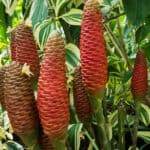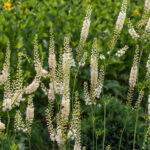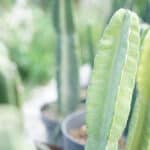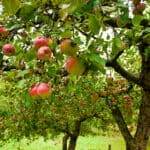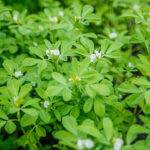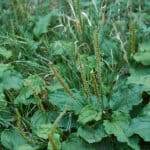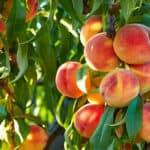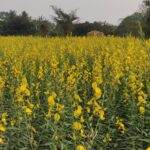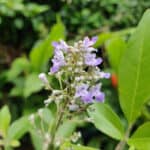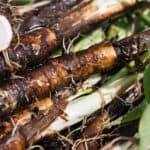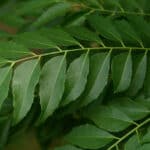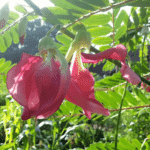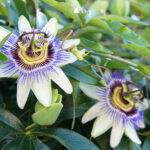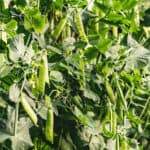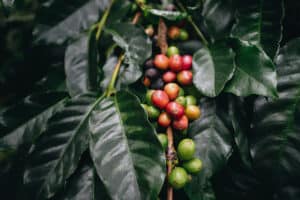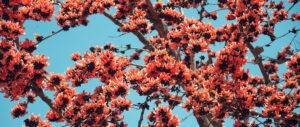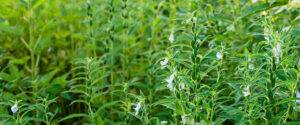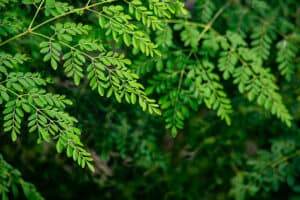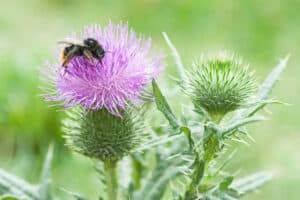
One of the annual visual delights I eagerly await is the sight of the Palash tree in full bloom.
I venture into the nearby forests, gathering some fallen flowers to make myself a warm tea or cool juice, further to which it’s always a delight to extract the dye from these flowers and use them for making infused bathing water.
I store the rest as a yearlong supply.
The flamy flowers are true to their description, demanding instant attention and admiration from everyone as they give an illusion of a flame far in the forest from a distance.
The traces of Palash tree and flowers can be found in ancient literature, poetry, storytelling, festive spirits and faith.
In Ayurveda, Palash is known as one of the most beneficial trees for human health and has been denoted as Brahmavriksha, meaning a divine tree.
Scientifically known as Butea monosperma, the Palash tree belongs to the family Fabaceae.
It is native to India and found across terrains of Sri Lanka, Nepal, Vietnam, Malaysia, Bangladesh, Laos, Cambodia, Indonesia Pakistan, Indonesia and Thailand.
These flowers are among the traditional sources of natural dye used since ages for dyeing fabric and other items.
The wood is used for making cutlery and building traditional basalt stone wells in our locality.
It’s a part of various rituals and celebrations, particularly during the Hindu festival of Holi, where its flowers are used to create natural dyes for vibrant celebrations.
The flowers and seeds are important in traditional Indian Ayurveda and Folk medicine, however, almost all other parts have utility across different local communities and the commercial market.
Different parts such as leaves, bark, gum, roots and wood are used daily for packaging, natural dye, timber, gum, fiber and more.
If you are a tea, natural medicine, dye or healing bath enthusiast, give this leguminous beauty a try and let it cast a spell on you too.
Plant Description
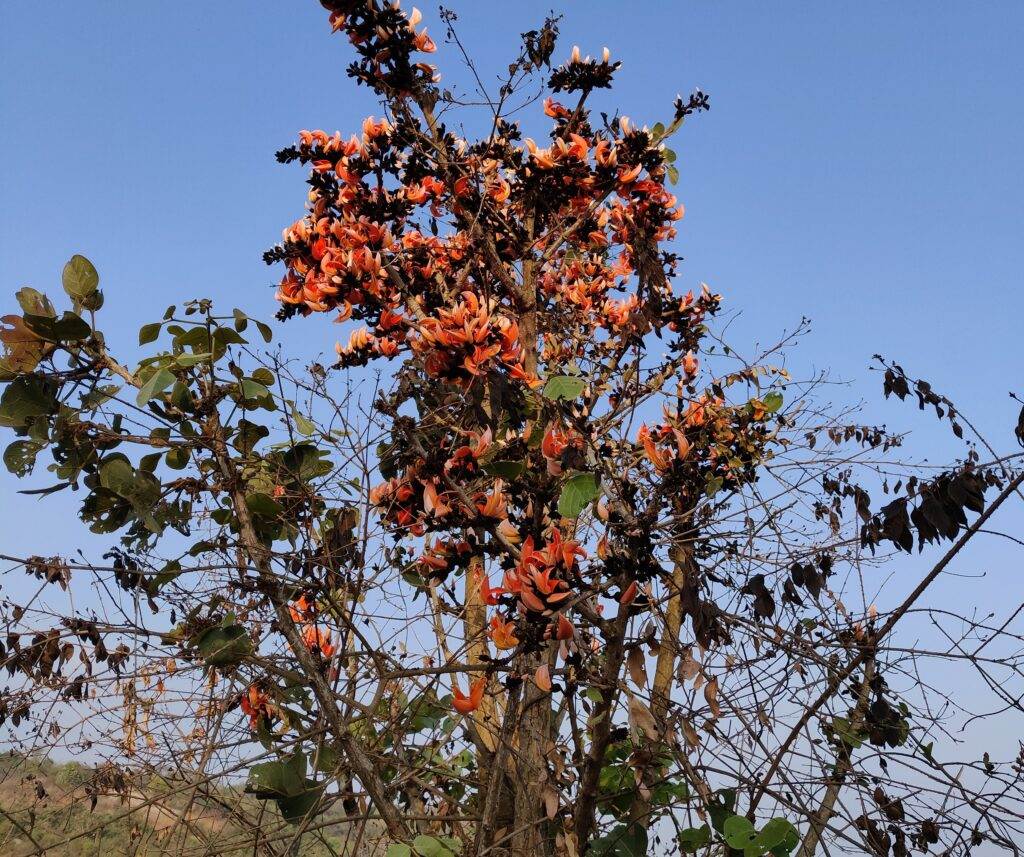
It is an intermediate dry-season deciduous tree that thrives in tropical and subtropical climates, preferring areas with a distinct dry season.
It’s a medium-height tree, growing up to 15 to 12 feet high on average however it can sometimes reach a height of 20+ meters.
The dimensions of the trunk range from 50 to 70 cm.
It has a distinctive appearance due to its grey bark and irregular and crooked branches.
And it can be spotted growing in full sun or partial shade of other deciduous trees.
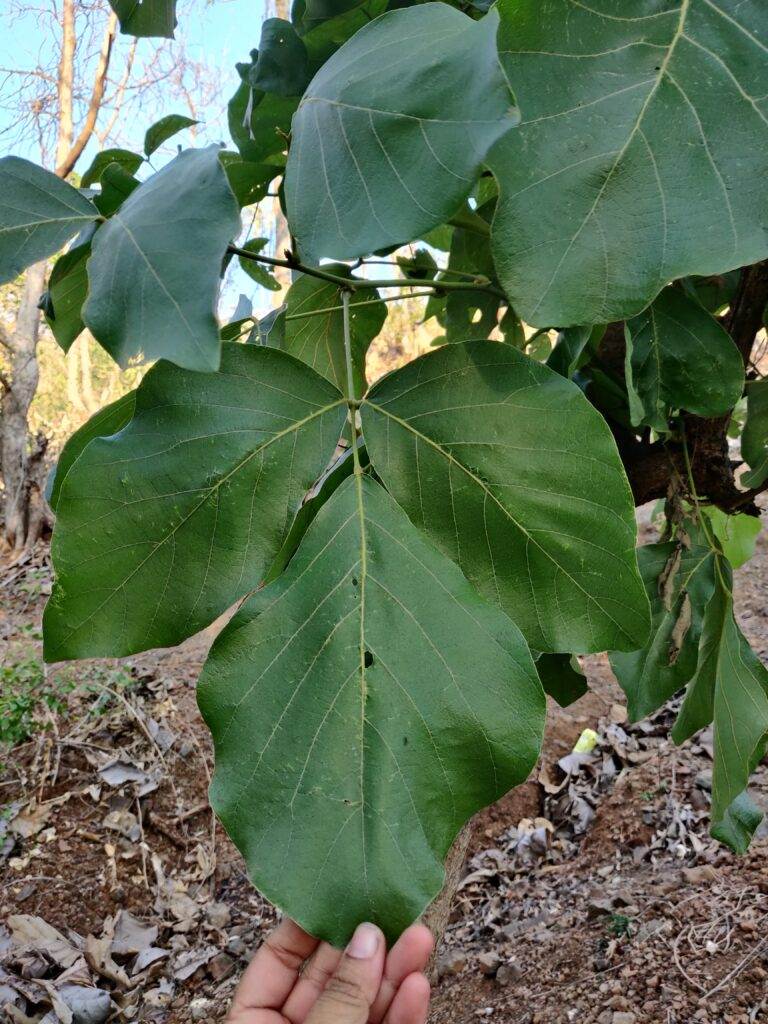
The leaves are pinnate, distinctly trifoliate, and elliptical or lanceolate-shaped, arranged on an 8 to 16 cm long petiole.
Each leaflet is 10 -15cm long and bright to dark green.
The leaves shed during the dry season and at the end of the flowering period, new leaves develop, they are initially maroonish to pale bronze-tinged green.

The timber is muddy white and is known for its softwood properties.
It can stand exposure to moisture and even underwater, thus the wood is used as a foundation layer for a water well construction.
The flowers, one of the most striking features of the tree, are vibrant reddish orange and bloom in clusters that appear like bright flames.
Birds are the chief pollinators and a wide range of birds can be seen enjoying the nectar through the blooming season.

The flower has a flat bottom petal where a bird can slide its beak into, while the upper part covers the plant’s stigma and anthers.
These pop out when the bird presses the flower’s base, almost like jaws opening outward from the branches.
This creates a comfy spot for birds to land as they look for some nectar inside.

As the birds slide their beaks in to get the nectar, their heads or throats rub against the folded petals with filaments carrying anthers and a style with a stigma and when the birds try to go deeper for the nectar, these filaments get exposed and transfer pollen onto the bird.
Then, when the bird visits another Palash tree, it might help fertilize that tree by carrying this pollen.
The seed pods are flat, about 15-20 cm long, green when tender, and turn off white to light brown as they mature.

They are lightweight and can be carried away from the plant by strong winds, landing in adjacent areas where they germinate in the upcoming wet season under favorable conditions.
The seeds are brown, flat, oval-shaped, enclosed in a protective coating and about 2 to 2.5cm long.
Traditional Regenerative Properties
Contribution to Soil Health
Being a leguminous plant, the Plash tree fixes atmospheric nitrogen into the soil which helps other plants and organisms.
The tree has a mix of taproot and fibrous root systems which helps prevent soil erosion by holding it together.
It’s one reason why the Palash tree is planted across the bunds of farms and open areas and thus it holds great potential in managing wastelands with degraded soils in regenerative designs.
The plant is sturdy and can withstand strong winds making it a great windbreak species, especially during the wet seasons.
Key Species for Native Biodiversity
It hosts nearly 30+ birds during its blooming periods like the Purple Sunbird, Common Myna, Common Tailorbird,, Plum-headed Parakeet, Oriental White-eye, Lesser Whitethroat, Golden-fronted Leafbird, Red-vented Bulbul, Chestnut-tailed Starling, Black Drongo, Rufus-bellied Treepie, Greater Racket-tailed Drongo, Black-rumped Woodpecker and more.
Here is a detailed list of birds recorded on the trees around the Jhansi region of Uttar Pradesh district in India from February to April.
Additionally, birds also prefer the tree for nesiting and roosting.
And organisms like squirrels, bees, butterflies and more also depend on the tree for necar and shelter.
Interesting Fact: The leaves attract beneficial insects and worms for forest litter decomposition.
Hedges & Beautification
The plants can be seen as hedges and ornamental plants, especially in the backyard or in front of living spaces.
The flowers and leaves are also decorative in religious processions, weddings, and other festive celebrations.
The flowers are offered to god, especially to lord Shiva during Shivaratri and to worship goddess Laxmi.
Medicinal Applications
Traditionally and to date, the flowers are used to treat swellings, they are crushed and applied to the affected area.
They are soaked in water and mixed with Mishri (natural sugar made by mixing sugarcane sap, also known as rock candy) to cure kidney pain and treat blood in urine and they are tied on the lower abdomen to cure urinary disorders.
The fresh root extract is used as drops to cure cataracts and eye infections.
The fresh root juice is used to manage and reduce the intensity of epileptic seizures.
The seeds are known for their fungicidal and bactericidal properties and are used to cure infections caused by fungi or bacteria.
They are also used as contraceptives.
The gum extracted from the tree is known as “Bengal kino”, “Palash Gond”, “Dhaak Gond” or “Kamarkas” and is used as a dye or tannin which is used in tanneries for leather tanning.
It is known for its Anti-tussive or anti-cough property of Kamarkas making it helpful in treatment of all cough related diseases.
The flowers are tonic and nutritive and are used to treat gastrointestinal issues, respiratory problems, skin diseases, and regulate blood sugar.
The bark powder is used to treat piles, stomach worms, and ulcers.
Interesting Fact: The seeds are among of the base ingredients in the Ayurvedic preparation called Aragwadhadi Ghritham which is a ghee (clarified cow milk butter) infused preparation used for treating skin conditions.
Host Species for Lac Bug
The tree is an important host for Laccifer lacca, an insect species native to Asia that makes it home on trees, a scarlet resin known as lac.
Traditionally the larc is used for making lacquerware, skin cosmetics, perfume, wood polish, ornaments like traditional lac bangles and dye for wool, silk and cotton in India and neighboring areas.
It is commercially refined to make shellac used in ammunition, airplanes, furniture polish, imitation fruits and flowers.
The shellac is melted into thin flakes for use as a varnish.
It helps local communities earn income as the tree produces the most las sticks per hectare compared to any other lac tree.
Leaves as a source of biodegradable plates and bowls
The leaves are used for making disposable plates by sewing them with tiny bamboo or coconut leaf sticks.
We call them Patravali in Marathi here in Maharashtra meaning a plate.
They are used for serving food during gatherings and the plates are disposed of in a freshly dug trench, later covered to help them decompose faster.
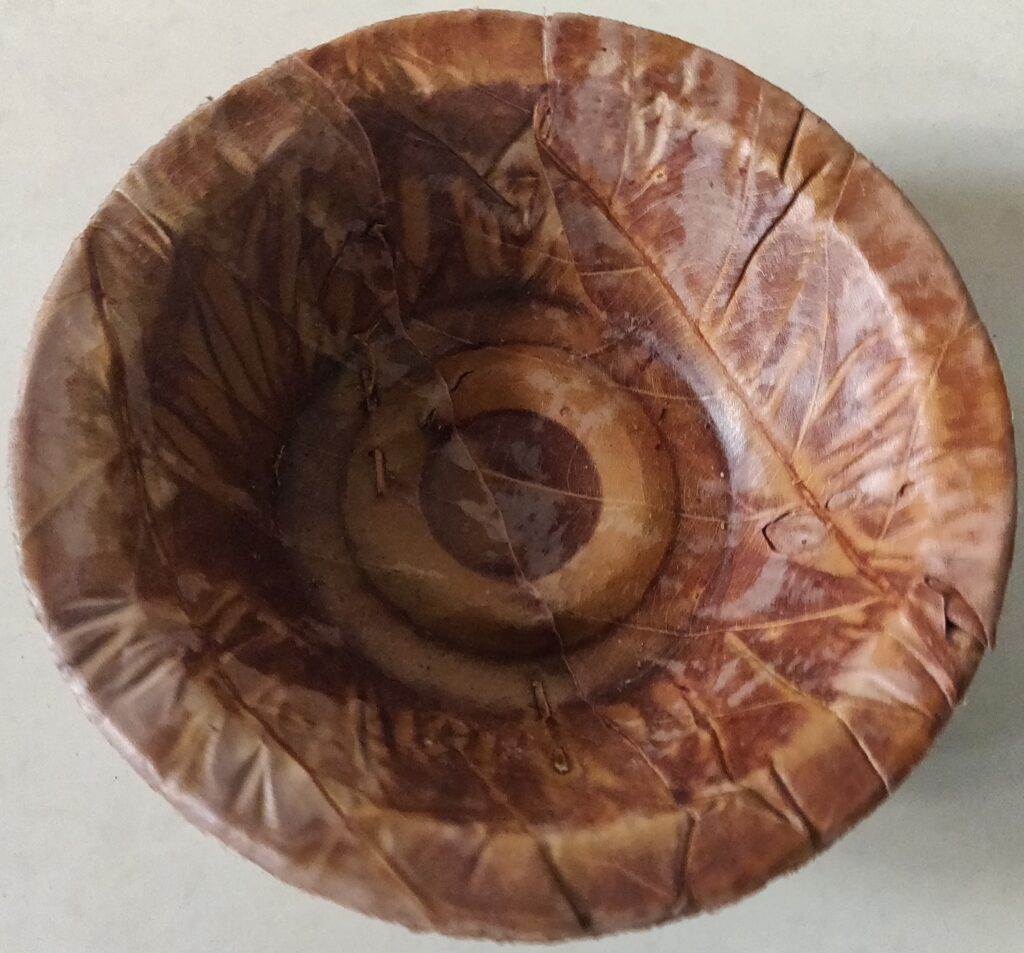
Leaves in Storage
The leaves are known for their durability and for layering grain and seed storage/ preservation containers and pits.
They can be seen used in traditional underground grain storage as well, used as an outer layer to create a thick barrier helping repel the pest.
Wood in Cutlery & Traditional Water Structures
The wood is known for its ability to survive moist conditions and for making handles for farming tools, spoons and bowls used for day-to-day kitchen activities.
The traditional stone wells are built by creating a base layer with mature Palash tree wood logs followed by stonework.
This wooden layer stays submerged in water for decades.
There are 200+ years old wells that are intact and functional.
The wood is considered excellent for charcoal and its also called the “Bastard Teak” because of its high calorific value.
Growing and Caring for Butea monosperma
Climate
It thrives in tropical and subtropical zones with warm climates however can tolerate a wide range and grows best where temperatures remain above freezing throughout the year.
It generally prefers moderate humidity however it can adapt to varying humidity levels as well.
Sun
It thrives in full sun however it can be seen growing under the canopy of other deciduous trees as well.
It needs at least 6 to 8 hours of direct daily sunlight for optimal growth and flowering.
Soil
The plant can adapt to diverse soil types however it thrives in well-draining sandy loam soils with a slightly acidic to neutral pH.
Water
When integrating in cultivated ecologies, it is important to periodically water the plant and keep the soils moist but not waterlogged in the initial years until it is established, This helps the plant establish a strong root system.
Once established, the tree can tolerate moderate drought and prolonged dry periods.
In nature, the young seedlings can be seen surviving dry seasons pretty well by themselves in their native zones.
Pest & Diseases
They can be affected by fungal diseases such as powdery mildew or root rot, particularly in poorly drained or waterlogged soil.
Proper drainage and good cultural practices can prevent these issues.
Maintenance
Minimal pruning for shaping or removing dead/diseased branches can be practiced in cultivated ecologies for maintaining height and volume.
However, mature Palash trees typically require minimal maintenance.
Propagating Palash
Palash is propagated from seeds.
The seeds are collected from dry pods that naturally fall from the tree.
They usually germinate during the first few monsoon showers in India and grow around a meter to 2 tall within the first 6 to 8 months.
The seed can be planted in soil or raised in a nursery bed/ bag.
Just use a regular well-draining potting mix.
Sow the seeds flat, an inch deep.


A Palash seed germinating from the pod itself without separation, sending a a tap root down and a shoot up.
Grown and captured by Samiksha Lohar.
The seeds do germinate just fine on the surface as well, it send out roots that dig through the surface and then slowly grow a shoot.
You can place the pots in shade to avoid quick evaporation of moisture.
It takes around a week to two for germination when the humidity is high.

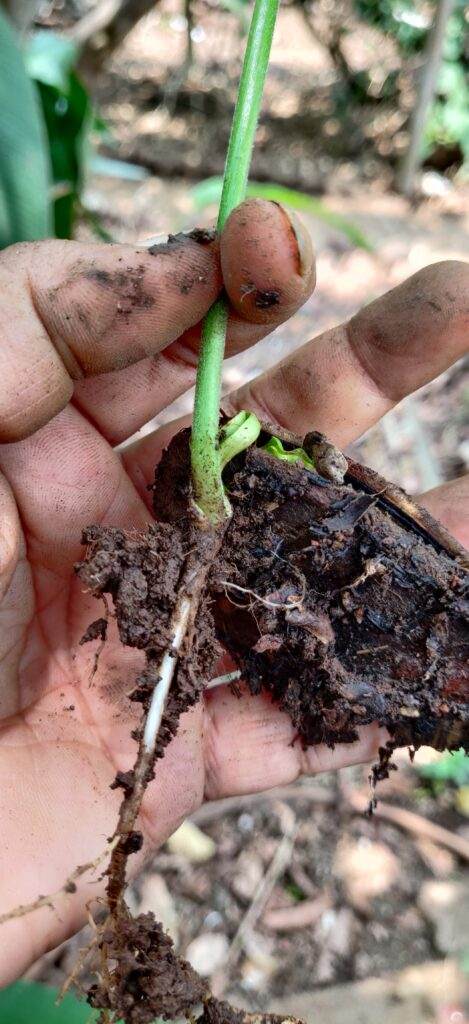
2-month-old Palash seedling.
Photo by Samiksha Lohar
You can transplant the plant to a permanent location or in a larger pot once the plant grows 2 to 3 sets of leaflets.
Selecting Spot
Select a well-draining spot in a dryer zone of your space with moderate humidity.
Dig a pit twice the size of the seedling rootball zone.
Mix some compost with the soil while refilling the pit and mulch around the plant to prevent moisture loss.
Keep the soil moist but not waterlogged for the initial couple of years.
Once the plant is established, the watering frequency can be reduced depending on how the plant responds.
Flowering Tip: In nature the plant blooms by late winter or the beginning of summer as the soil starts to dry up in the forest.
A similar pattern can be followed by reducing the irrigation frequency post-wet season to encourage foliage drop and flowering.
Harvesting and Storage
You can start harvesting the flowers once they bloom.
Fresh flowers can be used for brewing juice, dye, infused water for bathing and more.
The dry flowers fall on their own and these can be collected and stored in clean airtight containers for later usage for all of the above processes.
The seeds are extracted from fallen dry seed pods and the healthy ones are stored in gunny bags.
The leaves are used fresh for making plates and bows and left to dry to retain shape.
Moulds are used to get the desired depth and shape for bowls or
Brewing Palash Flower Tea
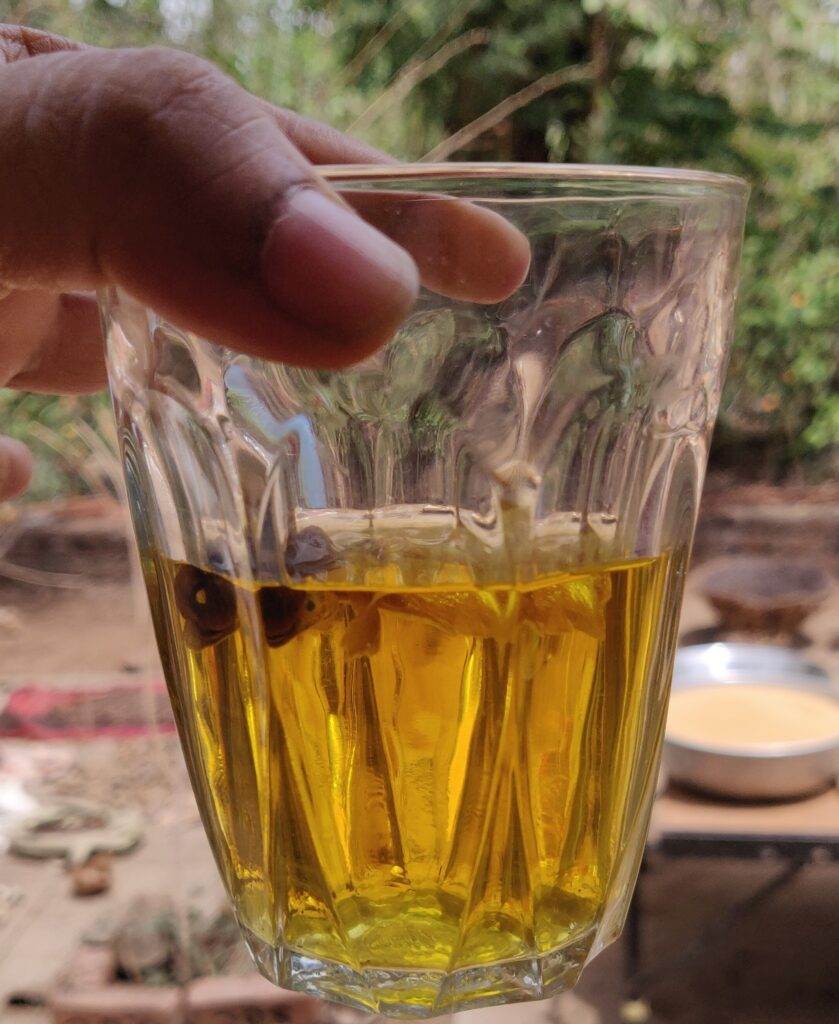
You can simply soak some dry or fresh flowers in a cup of water and let it sit for an hour or more to release the juices.
You can always boil the water, take it off the heat and add the flowers then for a quicker brew.
You can extract the juice in a similar way and dilute it to prepare your bathing water.
This helps manage skin infections and inflamation, I recommend doing it atleast once a month.
Some more Palash Benefits
The flowers are known to balance the Vata and Kapha dosha in Ayurveda.
The finely powdered seeds are used to treat intestinal worms inchildren.
The powdered is mixed with milk or water and about 4 tablespoon is taken to treat urinary problems and to eliminate urinary stones in adults.
A digestive supliment is made by mixing seed powder with lemon and honey to aid digestion.
The leaves are simply chewed to cure cough, cold and stomach problems and leaf juice garglong is preferred to treat sore throat problems.
The gum is used to prevent and heal cracked foot sole and it is known as a astringent for bowel health.
In some parts of India the root powder is used and an anti-dote against the snake bite.
The bark is used to treat inflamations by applying a semi solid paste.
Stem juice us used to treat thyroid.
The bark is slightly acidic and bitter and is used as aan appertizer, aphrodisiac and laxative.
In some parts its used to treat scorpion stings.
Concluding Thoughts & Hope
Trees like palash that bloom radiant flowers are a source of food for many birds, animals and insects.
They play and important role in maintaining the balance of nature and completing cycles.
However, these trees are least considered when it comes to plantation or reforestation on a larger scale as the nurseries are filled with other fast-growing or commercially encouraged species like Eucalyptus and Acacia which are mostly a challenge for native biodiversity to adapt to and reduce the availability of native species in India due to their invasive nature.
Supporting and encouraging trees like Palash (other being the Indian Coral Tree and Indian Silk Cotton Tree) holds hope for preserving and restoring the balance of native forests and humans together.
The leaves are promising substitutes for safe disposable cutlery, storage and packahging material and they reduce the dependence on large distance travel as the tree is found growing abundantly throught these south asian terrains.
A little thought and encouragement towards Palash holds a simple yet great potentain in solving our problem related to resources management and non biodegraradble waste management.
I hope this article helps keep the flame of the the forest burning in our heart, bright enough 🙂
Reference:
- (PDF) Palasha, a holy plant: Its phytochemistry, biological effects, and therapeutic uses (researchgate.net)
- D1501011823.pdf (iosrjournals.org)
- Bird List – (PDF) Avifauna Associated with Palash (Butea monosperma), State Flower of Uttar Pradesh, India | SSR Institute of International Journal of Life Sciences – Academia.edu








